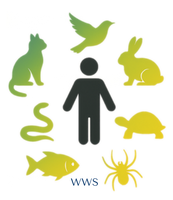🦠 Routes of Disease Transmission
🎯 Learning Objectives
-
Identify the main routes of disease transmission
-
Describe prevention and control measures
-
Apply knowledge to real-world scenarios in animal management
❓ What Is a Disease?
A disease is a condition that negatively affects an organism’s physical or mental functions. It may:
-
Disrupt normal structure or function
-
Cause specific symptoms or pain
-
Impact humans, animals, or plants
🧬 Disease Classification
🔹 Non-Communicable (Non-Infectious)
-
Not transferred between organisms
-
Causes: genetic, physiological, lifestyle, or environmental
-
Examples: heart disease, diabetes, cancer
🔹 Communicable (Infectious)
-
Transferred between organisms
-
Causes: viruses, bacteria, fungi, protozoa
-
Examples: influenza, measles, malaria
🧭 Other Classification Methods
Classification Type Description Examples
By Cause - Genetic, physiological, or deficiency. Sickle cell anaemia, metabolic disorders
By Duration - Acute (short-term), Chronic (long-term). Flu vs. diabetes
By Location - Local (specific area), Systemic (whole body). Skin infection vs. sepsis
🔄 Routes of Transmission
🤝 Direct Contact
-
Touching infected animals or surfaces
-
Examples: ringworm, rabies, canine distemper
🌬️ Airborne Transmission
-
Inhalation of droplets or aerosols
-
Influenced by droplet size and ventilation
-
Examples: kennel cough, feline URIs, rabbit RHD
🦟 Vector Transmission
-
Disease spread by living organisms (e.g., ticks, mosquitoes)
-
Biological vectors: the pathogen multiplies inside the vector
-
Mechanical vectors: pathogen carried externally
-
Examples: Lyme disease, leishmaniosis
🍽️ Contaminated Food & Water
-
Contact with infected waste or surfaces
-
Examples: Salmonella, Campylobacter, parasite ingestion
🛡️ Prevention & Control
✅ Biosecurity Measures
-
Vaccination
-
Hygiene protocols
-
Restricted access
-
Proper housing
-
Health monitoring
-
Isolation of sick animals
-
Cleaning & disinfection
-
Pest control
-
Waste management
-
Record-keeping
📍 Case Study: Bluetongue Virus (BTV-3)
-
🐄 Confirmed in Greater Manchester (Aug 2025)
-
🦌 Affects ruminants: sheep, cattle, goats, deer
-
🦟 Spread by Culicoides midges
-
⚠️ Symptoms: fever, swelling, lameness, reduced milk yield
-
🧭 Control: movement restrictions, surveillance zones
🔗 Useful Links



